The yurt is a symbol of the culture of all Turkic nomadic peoples. In fact, the word “yurt” means the parking place where it is constructed and is translated as homeland, fatherland.
 The yurt is a nomad’s home that fully satisfies their needs due to its convenience and practicality. It is quickly constructed, easily disassembled and easily transported during nomadic transitions from pasture to pasture. The felt covering does not allow rain, wind and cold to pass through.
The yurt is a nomad’s home that fully satisfies their needs due to its convenience and practicality. It is quickly constructed, easily disassembled and easily transported during nomadic transitions from pasture to pasture. The felt covering does not allow rain, wind and cold to pass through.
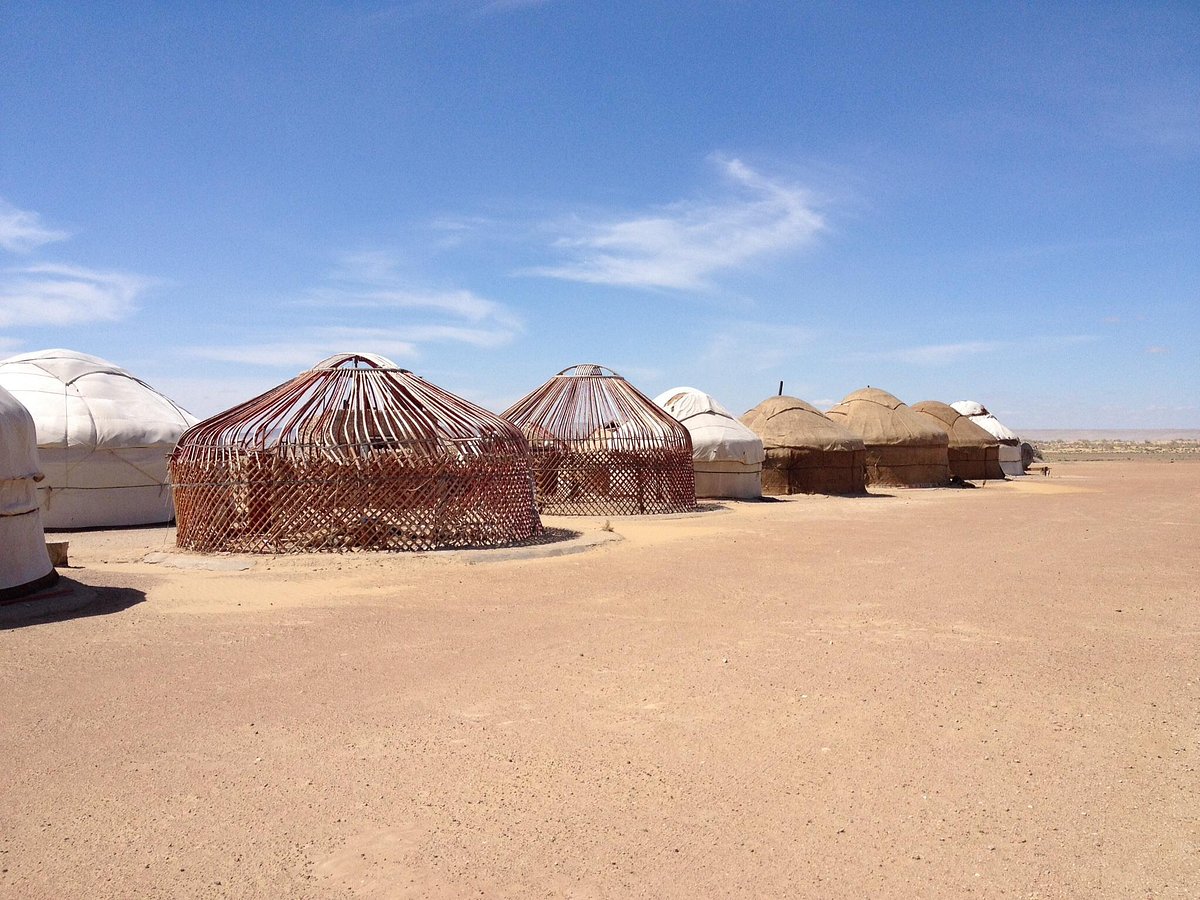 Installation of a Karakalpak yurt begins with the door. Until the 1940s and 1950s the doors were simple. Carving and painting doors in bright colors became popular later. In addition to the inner pair of wooden doors, the yurt also has an outer door made of a reed screen sewn to a base made of dense material.
Installation of a Karakalpak yurt begins with the door. Until the 1940s and 1950s the doors were simple. Carving and painting doors in bright colors became popular later. In addition to the inner pair of wooden doors, the yurt also has an outer door made of a reed screen sewn to a base made of dense material.
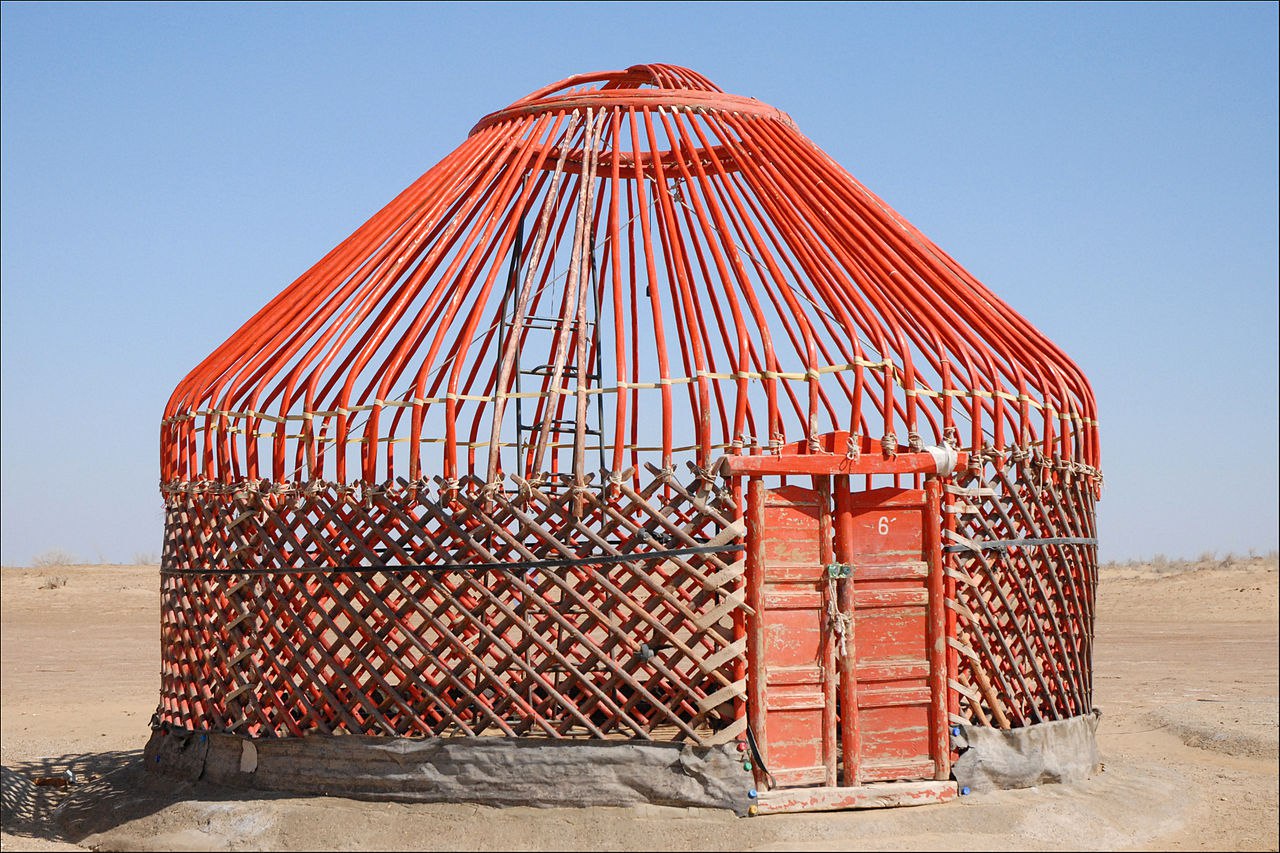 The walls of the yurt consist of a series of lattice sections (qanats), which means wings because they can be opened and closed. Different yurts are assembled from 6, 8, rarely 12 folding parts. When lattice sections are joined together to form a circle, completed by the addition of a yurt door, they are called kerege.
The walls of the yurt consist of a series of lattice sections (qanats), which means wings because they can be opened and closed. Different yurts are assembled from 6, 8, rarely 12 folding parts. When lattice sections are joined together to form a circle, completed by the addition of a yurt door, they are called kerege.
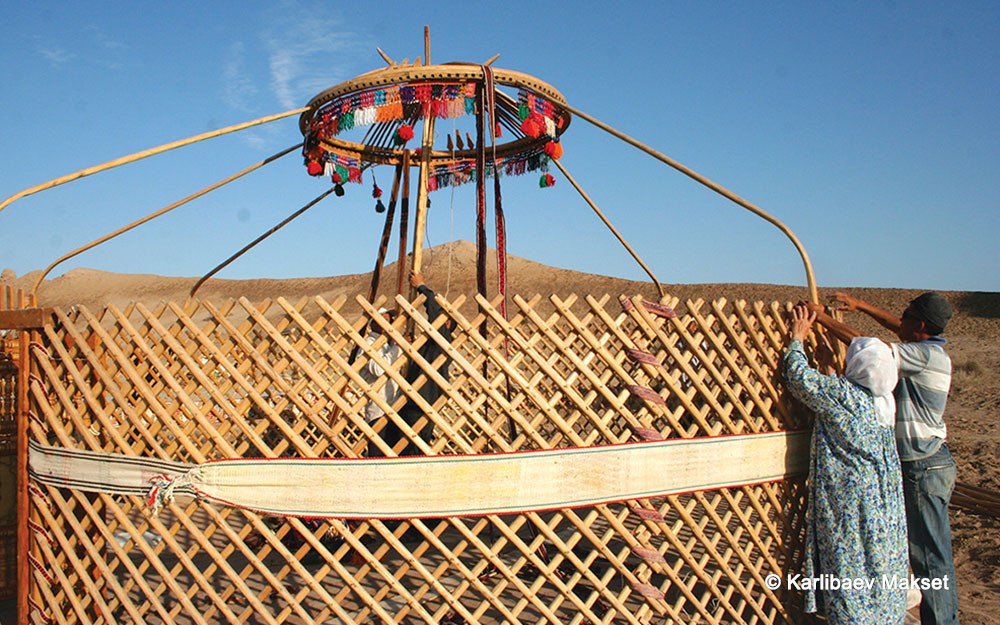 The outside of the kerege was lined with reed screens. In the past, people who could not afford felt for the roof of a yurt used reed screens. They can be easily unfolded to let in air in the summer.
The outside of the kerege was lined with reed screens. In the past, people who could not afford felt for the roof of a yurt used reed screens. They can be easily unfolded to let in air in the summer.
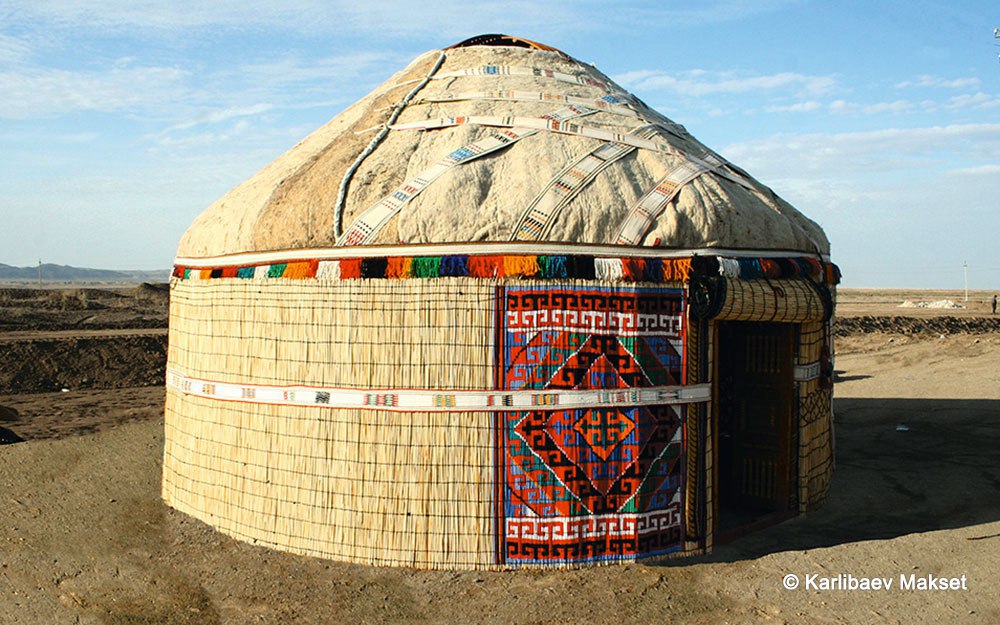 The roof of the yurt is formed by long poles (uwıqs), attached to the central round crown of the roof (shan'araq), consisting of two hoops. It holds the frame of the yurt, serves as a light window, and in the old days, when people lived in the yurt in winter, it served as a chimney, so the hearth was placed in the center of the room. The roof of a yurt is usually covered with three pieces of felt. The front and back parts of the roof are semicircular, the felt covering the smoke hole (tu’n’lik) is rectangular. Long ropes come from the corners of the felt covering; when it was necessary to open the smoke hole, one of the ropes was untied and the felt was pulled to the side.
The roof of the yurt is formed by long poles (uwıqs), attached to the central round crown of the roof (shan'araq), consisting of two hoops. It holds the frame of the yurt, serves as a light window, and in the old days, when people lived in the yurt in winter, it served as a chimney, so the hearth was placed in the center of the room. The roof of a yurt is usually covered with three pieces of felt. The front and back parts of the roof are semicircular, the felt covering the smoke hole (tu’n’lik) is rectangular. Long ropes come from the corners of the felt covering; when it was necessary to open the smoke hole, one of the ropes was untied and the felt was pulled to the side.
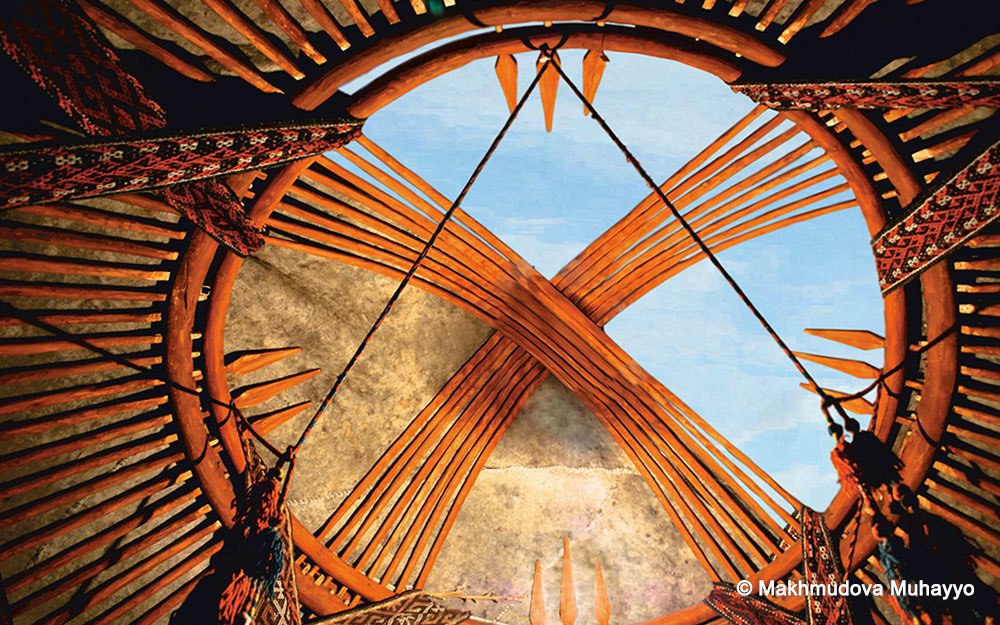 In the old days, handmade textile items for the yurt constituted the bride's dowry, which she prepared for the wedding under the guidance of her mother over the course of 6–8 years. The palette of textile decoration of the yurt copied the colors of native nature. It consisted of a calm, but at the same time rich range of ocher and red-brown colors. Black and white colors occupied a special place; they were used for the main background of the ornament and as patterned lines. An internal waist belt (ishki beldew) in the form of a strip 30-40 cm wide runs around the outside of the yurt with a pattern inward. It adds vital structural stability.
In the old days, handmade textile items for the yurt constituted the bride's dowry, which she prepared for the wedding under the guidance of her mother over the course of 6–8 years. The palette of textile decoration of the yurt copied the colors of native nature. It consisted of a calm, but at the same time rich range of ocher and red-brown colors. Black and white colors occupied a special place; they were used for the main background of the ornament and as patterned lines. An internal waist belt (ishki beldew) in the form of a strip 30-40 cm wide runs around the outside of the yurt with a pattern inward. It adds vital structural stability.
Woolen lint-free strip of red and black color (qızıl basqur) 60-70 cm wide plays an important constructive role in fixing the circumference of the roof and maintaining its slope.
A white strip (ak baskur) 40-50 cm wide, woven using a combined technique on a white cotton base and decorated with woolen pile, is located above the red strip with the decorated side inward. Its function is to fix the felt to prevent it from stretching.
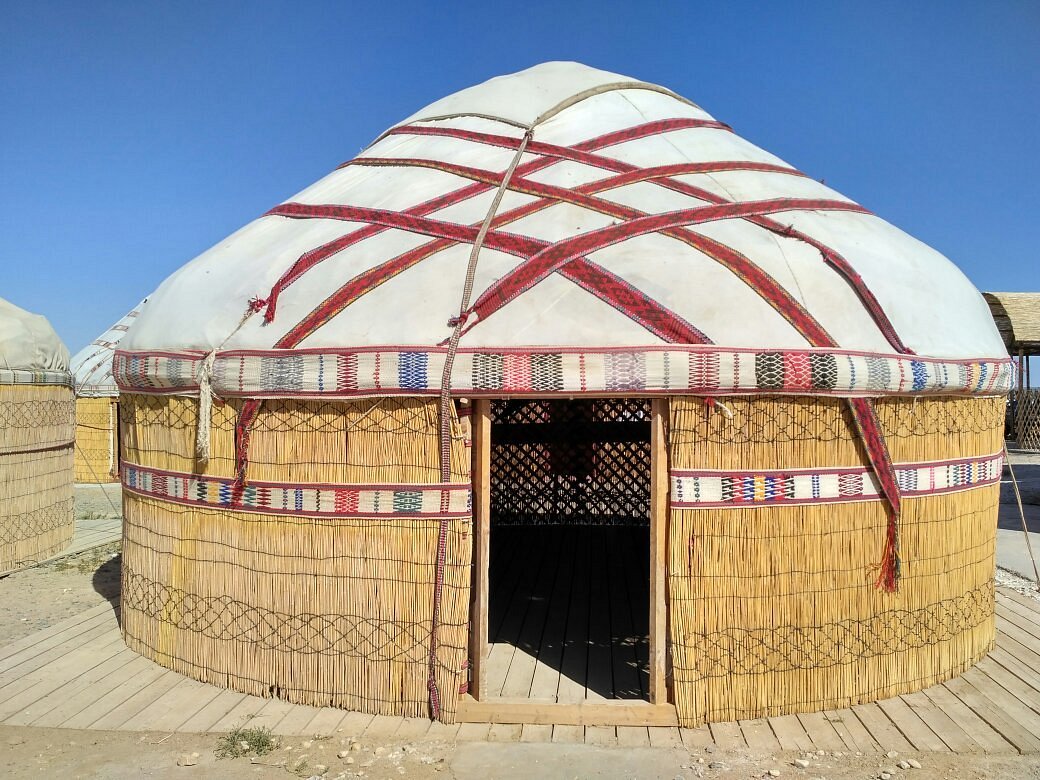
A set of brightly colored woolen cords with tassels at the ends (ayaqbaw) are hung from the dome of the yurt to create a greater decorative effect.
 The place of the owner of the house is located opposite the entrance of the yurt (to’r). The owner gave up his seat when receiving honored guests.
The place of the owner of the house is located opposite the entrance of the yurt (to’r). The owner gave up his seat when receiving honored guests.
The men's half was to the left of the entrance. Men's clothing, musical instruments, horse harness, tools of men's craft and hunting were kept here.
On the women's half there were bales of clothes, a hand mill (digirman), food storage bags (shanash), containers made of hollowed out pumpkins for storing water, and items of women's craft. There is usually very little furniture in a yurt - stands (sab-ayak) for cauldrons, large dishes and food, as well as a carved or painted wooden chest intended for storing things. Quilts (korpe) and mattresses (korpeshe) were usually stored on top of the chest.
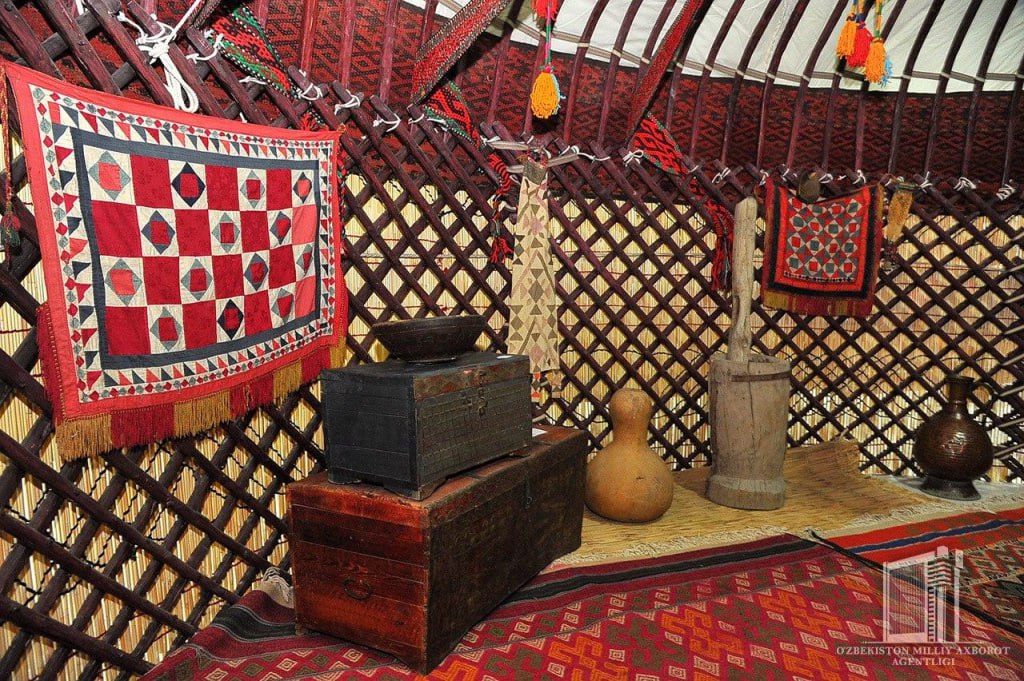 Since ancient times, people have identified the yurt with a model of space. In a yurt, the sacred zones were considered to be: the threshold (bosaga), the hearth (oshak) and the place of honor opposite the entrance (tor), above which a decorative accent was made using a grid of red patterned strips (kyzyl-kur).
Since ancient times, people have identified the yurt with a model of space. In a yurt, the sacred zones were considered to be: the threshold (bosaga), the hearth (oshak) and the place of honor opposite the entrance (tor), above which a decorative accent was made using a grid of red patterned strips (kyzyl-kur).
The dome of the yurt and the hearth embodied the symbol of the sun and fire. The crosshairs of the yurt dome were oriented to the cardinal points. In warm weather it was open and made it possible to observe the heavenly bodies.
